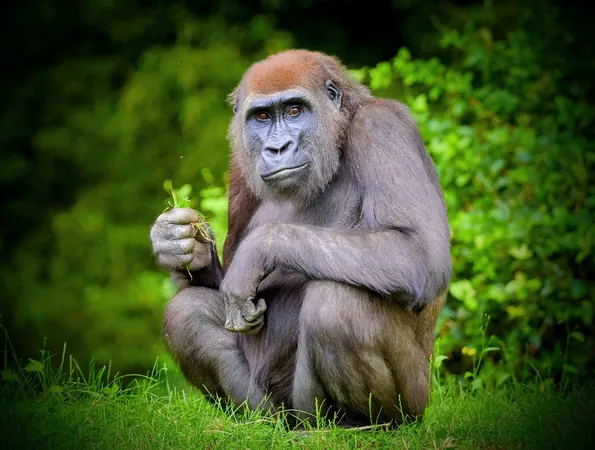
Unraveling the Dynamic Origins of Early Apes in a Fire-Swept World
2025-06-16
Author: Wei Ling
The Crucial Role of the Environment in Ape Evolution
Human evolution extends beyond just bones; it is intricately tied to the rich tapestry of forests, soils, and climates that served as habitats for early apes long before our ancestors walked upright. While great apes diverged from other primates approximately 25 million years ago, the lineage leading to modern humans only emerged around 5 million years ago. This epoch saw forests flourish and fade, volcanic eruptions reshaping landscapes, and creatures adjusting to their ever-changing environments.
A Time Capsule of Life in Western Kenya
One of the most revealing fossil sites is Koru 16 in western Kenya, which gives a glimpse into life during the early Miocene, about 20 million years ago. Preserved under layers of ash from the now-extinct Tinderet Volcano, Koru 16 acts as a remarkable time capsule. New research spearheaded by Venanzio Munyaka illuminates the profound connection between ape evolution and the ecosystems they inhabited.
From the Ground Up: Unveiling Koru 16's Fossil Treasure
For nearly a century, Koru 16 has intrigued scientists, beginning with the discovery of its first primate fossils in 1927 by renowned anthropologist Louis Leakey. Recent advancements have breathed new life into the exploration of this site, with detailed investigations conducted between 2013 and 2023 revealing nearly 1,000 fossilized leaves and numerous vertebrate remains.
The findings include bones from 25 different species, such as pythons, rodents, and three varieties of apes: Proconsul africanus, Proconsul major, and a newly identified large-bodied nyanzapithecine. Such diversity indicates that Koru 16 was a cradle of early ape development.
Exploring Ape Survival in a Shifting Forest
By employing paleosol chemistry, leaf structure analysis, and fossilized tree stumps, researchers reconstructed the vibrant ecosystem of Koru 16 millions of years ago. Findings suggest a warm, tropical forest frequently altered by volcanic activity, wildfires, and seasonal floods, yet teeming with life.
With around 2,000 mm of rainfall annually and temperatures possibly exceeding 25°C, this dynamic environment fostered a variety of vegetation, including deciduous trees. Munyaka emphasized, "By studying the soil, fossils, and tree stumps, we could recreate the forest’s climate," highlighting how the ecosystem's instability posed both challenges and opportunities for its inhabitants.
Fossilized Leaves: A Window into the Past
The plant fossils uncovered present a vivid characterization of Koru 16’s dense yet diverse forest. Researchers identified 18 unique leaf types, indicating a rapidly changing landscape where plants quickly adapted following disruptions like fires. These characteristics reflect a mixed canopy, influencing how early apes navigated their habitat.
The Richness of Life Among the Ashes
In examining the fauna alongside these plants, the evidence supports the notion of a thriving ecosystem. Alongside the three ape species, fossils of large pythons and various rodents imply a rich, layered habitat. These findings reveal that Koru 16 was a bustling hub of primate evolution.
Adapting to an Ever-Changing Environment
Researchers propose that the fluctuating living conditions may have influenced the evolution of early apes, prompting adaptations in behavior, diet, and social habits. Rather than a tranquil rainforest, early apes thrived amid a turbulent landscape that required them to navigate numerous challenges.
Redefining Ape Origins: Adaptability Over Stability
The research at Koru 16 shifts our understanding of ape origins. Rather than evolving in static rainforests, early apes thrived in an ecosystem marked by disturbance. By successfully navigating these fluctuations, primates honed adaptable traits crucial for survival.
This extraordinary site, rich with ash and life, offers a holistic view of the world inhabited by early apes—not just a tale of bones, but one woven with threads of climate, ecology, and survival. The journey towards humanity began not solely with upright walking but also in diverse canopies and dynamic landscapes.
A New Chapter in Primate Evolution Research
This groundbreaking study has been published in the journal Paleoceanography and Paleoclimatology, inviting further exploration into the complexities of our evolutionary past.




 Brasil (PT)
Brasil (PT)
 Canada (EN)
Canada (EN)
 Chile (ES)
Chile (ES)
 Česko (CS)
Česko (CS)
 대한민국 (KO)
대한민국 (KO)
 España (ES)
España (ES)
 France (FR)
France (FR)
 Hong Kong (EN)
Hong Kong (EN)
 Italia (IT)
Italia (IT)
 日本 (JA)
日本 (JA)
 Magyarország (HU)
Magyarország (HU)
 Norge (NO)
Norge (NO)
 Polska (PL)
Polska (PL)
 Schweiz (DE)
Schweiz (DE)
 Singapore (EN)
Singapore (EN)
 Sverige (SV)
Sverige (SV)
 Suomi (FI)
Suomi (FI)
 Türkiye (TR)
Türkiye (TR)
 الإمارات العربية المتحدة (AR)
الإمارات العربية المتحدة (AR)